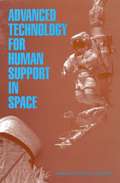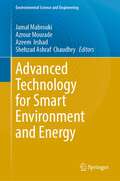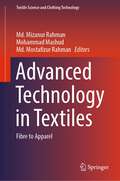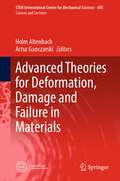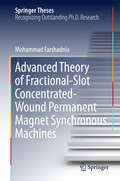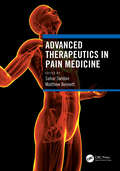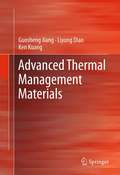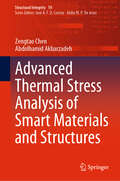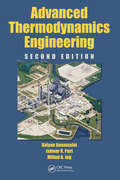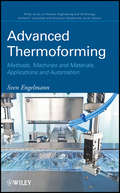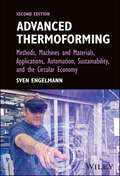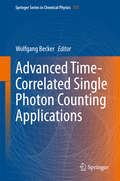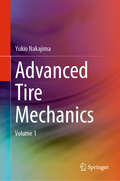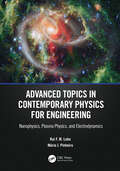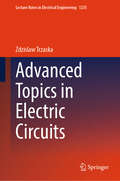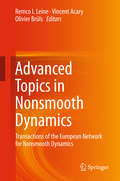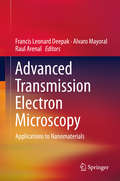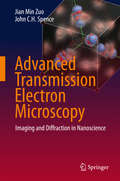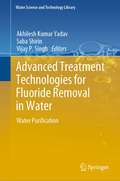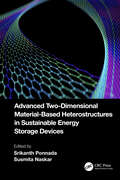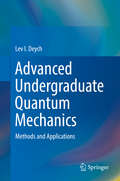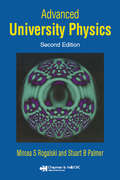- Table View
- List View
Advanced Technology for Human Support in Space
by Committee on Advanced Technology for Human Support in SpaceAdvanced Technology for Human Support in Space was written in response to a request from NASA's Office of Life and Microgravity Sciences and Applications (OLMSA) to evaluate its Advanced Human Support Technology Program. This report reviews the four major areas of the program: advanced life support (ALS), environmental monitoring and control (EMC), extravehicular activities (EVA), and space human factors (SHF). The focus of this program is on long-term technology development applicable to future human long-duration space missions, such as for a hypothetical new mission to the Moon or Mars.
Advanced Technology for Smart Environment and Energy (Environmental Science and Engineering)
by Jamal Mabrouki Azrour Mourade Azeem Irshad Shehzad Ashraf ChaudhryThis book presents smart energy management in the context of energy transition. It presents the motivation, impacts and challenges related to this hot topic. Then, it focuses on the use of techniques and tools based on artificial intelligence (AI) to solve the challenges related to this problem. A global diagram presenting the general principle of these techniques is presented. Then, these techniques are compared according to a set of criteria in order to show their advantages and disadvantages with respect to the conditions and constraints of intelligent energy management applications in the context of energy transition. Several examples are used throughout the white paper to illustrate the concepts and methods presented. An intelligent electrical network (smart grid—SG) includes heterogeneous and distributed electricity production, transmission, distribution and consumption components. It is the next generation of electricity network able to manage electricity demand (consumption/production/distribution) in a sustainable, reliable and economical way taking into account the penetration of renewable energies (solar, wind, etc.). Therefore, a (SG) smart grid also includes an intelligent layer that analyzes the data provided by consumers as well as that collected from the production side in order to optimize consumption and production according to weather conditions, the profile and habits of the consumer. In addition, this system can improve the use of green energy through renewable energy penetration and demand response.
Advanced Technology in Textiles: Fibre to Apparel (Textile Science and Clothing Technology)
by Md. Mizanur Rahman Mohammad Mashud Md. Mostafizur RahmanThis book highlights the latest technology in textile processing along with the application of eco-friendly chemicals and reagents. As textile is the second basic human need, this industry assimilates a large share in the world economy. Nonetheless, nothing should be accomplished compromising sustainability; therefore updated technology and modern machineries are being used in the textile processing. It is not only for enhancing the efficiency but also to reduce waste and energy consumption. Moreover, Nano particles and Bio-chemicals are assumed to become integral part in the future manufacturing system. In this book, the numerical and investigation results will be presented to highlight the mentioned topics so that the application is lucidly comprehended. In a nutshell, this book is supposed to cover all the vibrant innovations in the manufacturing arena in textiles in consideration with ecological balance as well as breakthroughs in applied technology assumed to veer the general concept of maintenance of that machineries.
Advanced Theories for Deformation, Damage and Failure in Materials (CISM International Centre for Mechanical Sciences #605)
by Holm Altenbach Artur GanczarskiThe book introduces advanced theories for deformation, damage, and failure in materials. The overall continuum mechanical framework was marked out and added by creep and damage mechanics of materials at elevated temperatures. The time-dependent and time-independent models of cyclic plasticity for low cycle and thermomechanical fatigue life assessment were specified in a very special manner: instead of three-dimensional statements, only one-dimensional rheological models were discussed. Anisotropic plasticity during non-proportional loading and anisotropy of yield/failure criteria is more and more important in modern applications. It is showing how the limit states of materials can be estimated. In addition, the damage and failure of composite materials demonstrate the possibility to extend continuum mechanics to continuum damage mechanics of composite materials.
Advanced Theory of Fractional-Slot Concentrated-Wound Permanent Magnet Synchronous Machines (Springer Theses)
by Mohammad FarshadniaThis book focuses on the analytical modeling of fractional-slot concentrated-wound (FSCW) interior permanent magnet (IPM) machines and establishes a basis for their magnetic and electrical analysis. Aiming at the precise modeling of FSCW IPM machines’ magnetic and electrical characteristics, it presents a comprehensive mathematical treatment of the stator magneto-motive force (MMF), the IPM rotor non-homogeneous magnetic saturation, and its airgap flux density. The FSCW stator spatial MMF harmonics are analytically formulated, providing a basis on which a novel heuristic algorithm is then proposed for the design of optimal winding layouts for multiphase FSCW stators with different slot/pole combinations. In turn, the proposed mathematical models for the FSCW stator and the IPM rotor are combined to derive detailed mathematical expressions of its operational inductances, electromagnetic torque, torque ripple and their respective subcomponents, as a function of the machine geometry and design parameters. Lastly, the proposed theories and analytical models are validated using finite element analysis and experimental tests on a prototype FSCW IPM machine.
Advanced Therapeutics in Pain Medicine
by Sahar Swidan and Matthew BennettChronic pain places a tremendous burden on both the patient and the healthcare system. The use of opioids to address pain has resulted in negative impacts. As practitioners work to undo the current opioid crisis, options to manage pain need a new approach. Advanced Therapeutics in Pain Medicine offers pioneering approaches to this intransigent problem providing a functional medicine approach toward treating pain. This book is dedicated to the advancement of non-opioid therapeutic options that offer real progress in reaching a future of better pain management. With an emphasis on pathophysiology, chapters review various types of pain and propose comprehensive treatment plans. These include manual therapies, novel pharmacologic and plant-based approaches, hormonal effects on pain pathways, as well as psychological and lifestyle interventions. Features · Written by a multi-discplinary team, the book provides clinicians with multiple non-opioid treatment considerations. · Enables practitioners to shift from a “one size fits all’ treatment approach toward individualized patient care. · Includes case studies to help educate the provider on how to implement treatment plans in practice. Written by a team of physicians, pharmacists, psychologists and researchers, this important book offers a much needed step forward in optimizing pain care and benefits practitioners who care for patients experiencing chronic pain.
Advanced Thermal Management Materials
by Ken Kuang Liyong Diao Guosheng JiangAdvanced Thermal Management Materials provides a comprehensive and hands-on treatise on the importance of thermal packaging in high performance systems. These systems, ranging from active electronically-scanned radar arrays to web servers, require components that can dissipate heat efficiently. This requires materials capable of dissipating heat and maintaining compatibility with the packaging and dye. Coverage includes all aspects of thermal management materials, both traditional and non-traditional,with an emphasis on metal based materials. An in-depth discussion of properties and manufacturing processes, and current applications are provided. Also presented are a discussion of the importance of cost, performance and reliability issues when making implementation decisions, product life cycle developments, lessons learned and future directions.
Advanced Thermal Stress Analysis of Smart Materials and Structures (Structural Integrity #10)
by Zengtao Chen Abdolhamid AkbarzadehThis is the first single volume monograph that systematically summarizes the recent progress in using non-Fourier heat conduction theories to deal with the multiphysical behaviour of smart materials and structures. The book contains six chapters and starts with a brief introduction to Fourier and non-Fourier heat conduction theories. Non-Fourier heat conduction theories include Cattaneo-Vernotte, dual-phase-lag (DPL), three-phase-lag (TPL), fractional phase-lag, and nonlocal phase-lag heat theories. Then, the fundamentals of thermal wave characteristics are introduced through reviewing the methods for solving non-Fourier heat conduction theories and by presenting transient heat transport in representative homogeneous and advanced heterogeneous materials. The book provides the fundamentals of smart materials and structures, including the background, application, and governing equations. In particular, functionally-graded smart structures made of piezoelectric, piezomagnetic, and magnetoelectroelastic materials are introduced as they represent the recent development in the industry.A series of uncoupled thermal stress analyses on one-dimensional structures are also included. The volume ends with coupled thermal stress analyses of one-dimensional homogenous and heterogeneous smart piezoelectric structures considering different coupled thermopiezoelectric theories. Last but not least, fracture behavior of smart structures under thermal disturbance is investigated and the authors propose directions for future research on the topic of multiphysical analysis of smart materials.
Advanced Thermodynamics Engineering (Applied and Computational Mechanics)
by Kalyan Annamalai Ishwar K. Puri Milind A. JogAdvanced Thermodynamics Engineering, Second Edition is designed for readers who need to understand and apply the engineering physics of thermodynamic concepts. It employs a self-teaching format that reinforces presentation of critical concepts, mathematical relationships, and equations with concrete physical examples and explanations of application
Advanced Thermoforming
by Sven EngelmannIntroduces the latest innovations in thermoforming materials, processes, and applications Advanced Thermoforming brings readers fully up to date with the latest standards, processes, materials, and applications in the field. From forming to filling to sealing processes, the author explains everything that can now be accomplished using the most advanced thermoforming technologies available. Moreover, readers learn how to fully leverage these technologies in order to design and manufacture products that meet all specifications at minimum cost and maximum efficiency. Emphasizing the application of advanced thermoforming for the production of technical parts and packaging, the book: Guides readers through all facets of development, design, and machine and mold technology Recommends new technologies that offer higher productivity, better quality, and lower costs Describes common raw materials used in thermoforming, including how specific materials affect the production process Explains the proper handling of semi-finished products and formed parts Sets forth the basic principles of extrusion, an essential process underlying thermoforming Introduces the latest software techniques to simulate the thermoforming of new products Throughout the book, readers learn about the latest innovations in thermoforming, from thermoformed automobile body parts to fully automated packaging assembly lines. The author offers valuable content from his interviews with leading industrial thermoformers, sharing insights and tips from their years of hands-on experience with readers. With Advanced Thermoforming as their guide, polymer and plastics engineering professionals and students can now explore and exploit the full range of possibilities that thermoforming technology offers.
Advanced Thermoforming: Methods, Machines and Materials, Applications, Automation, Sustainability, and the Circular Economy (Wiley Series On Polymer Engineering And Technology Ser. #8)
by Sven EngelmannADVANCED THERMOFORMING Overview of advanced technologies in thermoforming including forming, filling, and sealing processes, and practical applications in various industries Advanced Thermoforming offers an overview of and new insights into thermoforming by comparing current and new standards for forming and mold technologies, presenting concepts from the practitioner’s perspective in a case-study format showing the possibilities of automated processes, reviewing the forming, filling, sealing processes, and applications of technical parts and packaging. The reader is guided along the path of design and development for machine and mold technologies and production processes. Along with updated content, this revised Second Edition adds new coverage of sustainability in packaging, circular economy principles, mold technology, electromotive applications, and developments in new polymeric materials. The text opens thermoforming to new applications and demands on plastic parts by covering advances in thermoforming machines, molds, and automation. Advanced Thermoforming covers topics such as: Basics of thermoforming and thermoplastics, production of semifinished products, extrusion, and coextrusion Introduction to both heavy and thin gauge thermoforming New approaches for more sustainable rigid packaging through thermoforming Fuel tank production on sheet machines, automotive body and commercial vehicle applications, and production of refrigerator liners Sustainability and circular economy principles in thermoforming Presenting an impressive variety of advanced thermoforming technologies in a very readable form, Advanced Thermoforming is an essential reference for polymer and plastics engineers as well asprocessors, technical engineers, R & D managers, new product development managers, automotive engineers, technicians, and equipment designers.
Advanced Time-Correlated Single Photon Counting Applications (Springer Series in Chemical Physics #111)
by Wolfgang BeckerThis book is an attempt to bridge the gap between the instrumental principles of multi-dimensional time-correlated single photon counting (TCSPC) and typical applications of the technique. Written by an originator of the technique and by sucessful users, it covers the basic principles of the technique, its interaction with optical imaging methods and its application to a wide range of experimental tasks in life sciences and clinical research. The book is recommended for all users of time-resolved detection techniques in biology, bio-chemistry, spectroscopy of live systems, live cell microscopy, clinical imaging, spectroscopy of single molecules, and other applications that require the detection of low-level light signals at single-photon sensitivity and picosecond time resolution.
Advanced Tire Mechanics
by Yukio NakajimaThis book highlights the mechanics of tire performance, offering detailed explanations of deriving basic equations for the fundamental properties of tires, and discussing ways to improve tire performance using these equations. It also compares the theory with practical measurements. The book commences with composite mechanics, which is the fundamental theory for belt and carcass tires, and covers classical, modified and discrete lamination theory. It then addresses the theory of tire shape and spring properties and the mechanics of tread pattern contact properties, as was well as the performance of various tires. This comprehensive book is a valuable resource for engineers involved in tire design and offers unique insights and examples of improvement of tire performances.
Advanced Topics in Contemporary Physics for Engineering: Nanophysics, Plasma Physics, and Electrodynamics
by Rui F. Lobo Mário J. PinheiroThis book highlights cutting-edge topics in contemporary physics, discussing exciting advances and new forms of thinking in evolving fields with emphases both on natural phenomena and applications to modern engineering. It provides material for thought and practice in nanophysics, plasma physics, and electrodynamics. Nanophysics and plasmas are synergic physical areas where the whole is more than the sum of the parts (quantum, atomic and molecular, electrodynamics, photonics, condensed matter, thermodynamics, transport phenomena). The authors emphasize both fundamentals and more complex concepts, making the contents accessible as well challenging. Nanoscale properties and physical phenomena are explained under the umbrella of quantum physics. Advances made in the physical knowledge of the nanoworld, and its metrology are addressed, along with experimental achievements which have furthered studies of extreme weak forces present at nano- or sub-micron scales. The book does not focus in detail on the diversity of applications in nanotechnology and instrumentation, considering that the reader already has basic prior knowledge on that. It also covers an introduction to plasma universe phenomenology, the basics of advanced mathematics applied to the electromagnetic field, longitudinal forces in the vacuum, concepts of helicity and topological torsion, SU(2) representation of Maxwell equations, 2D representation of the electromagnetic field, the use of the fractional derivative, and ergontropic dynamics. The chapters include theory, applications, bibliographic references, and solved exercises. The synergies of the book’s topics demonstrate their potential in critical issues, such as relieving humans from barriers imposed by energetic and entropic dependencies and penetrating the realm of weak forces at the nanoscale. The book will boost both post-graduate students and mature scientists to implement new scientific and technological projects.
Advanced Topics in Electric Circuits (Lecture Notes in Electrical Engineering #1235)
by Zdzislaw TrzaskaThis book is addressed to researchers and practitioners in the theory and applications of electric circuits. It can also serve as a textbook for Ph.D. students examining applications of modern mathematics to important issues emerging nowadays more and more often in advanced electrical and electronic systems. The book offers effective tools to facilitate the study of all those circuits and systems increasingly penetrating our world, helping to discover their hidden beauty. The material is presented in twelve chapters divided into sections. Usually, first sections are of an introductory nature, explain studied phenomena and announce numerical results. More advanced investigations are presented in subsequent sections. The center of concern is set on existing modern methods as well as continuously emerging new methods of investigations useful for researchers, engineers and practitioners active in many interdisciplinary fields, where physics, electrochemistry, and electric circuits play a key role. Coverage includes: • Principles of optimal operations of electrical circuits; • The equilibrium state of the circuit as a stationary point of its power functional; • The Gibbs effect and its consequences for circuit analysis; • Accurate calculation of complex dynamic circuits operating in non-sinusoidal periodic states; • Energy hysteresis loops in non-sinusoidal periodic states of circuits; • Optimal transformations of elements in three-phase circuits; • Analog and digital filters; • Fractals and their structures and measures; • Fibonacci, Sierpiński and Cantor circuits; • Chaos in electrical circuits; •Electrochemical impedance spectroscopy; •Circuits with nanostructures and their properties; •Circuits of fractional orders; •AI in electrical circuits. This is the first extensive description of these topics and the interpretations of analytical results and those obtained from computer simulations with MATLAB environments. Special attention is paid to nonlinear electric circuits and finally the presentation is extended to effective applications of the achievements of modern AI. Numerous examples and exercises illustrate main results of the book. The book provides readers with a better understanding of origins and properties of many new circuit structures made possible by nanotechnology and atomic microscopy.
Advanced Topics in Nonsmooth Dynamics: Transactions of the European Network for Nonsmooth Dynamics
by Vincent Acary Remco Leine Olivier BrülsThis book discusses emerging topics in the area of nonsmooth dynamics research, such as numerical methods for nonsmooth systems, impact laws for multi-collisions, nonlinear vibrations and control of nonsmooth systems. It documents original work of researchers at the European Network for NonSmooth Dynamics (ENNSD), which provides a cooperation platform for researchers in the field and promotes research focused on nonsmooth dynamics and its applications. Since the establishment of the network in 2012, six ENNSD symposia have been organized at different European locations. The network brings together 40 specialists from 9 different countries in and outside Europe and a wealth of scientific knowledge has been gathered and developed by this group of experts in recent years. The book is of interest to both new and experienced researchers in the field of nonsmooth dynamics. Each chapter is written in such a way as to provide an introduction to the topic for researchers from other fields.
Advanced Topics in Quantum Field Theory
by M. ShifmanSince the advent of Yang-Mills theories and supersymmetry in the 1970s, quantum field theory - the basis of the modern description of physical phenomena at the fundamental level - has undergone revolutionary developments. This is the first systematic and comprehensive text devoted specifically to modern field theory, bringing readers to the cutting edge of current research. The book emphasizes nonperturbative phenomena and supersymmetry. It includes a thorough discussion of various phases of gauge theories, extended objects and their quantization, and global supersymmetry from a modern perspective. Featuring extensive cross-referencing from traditional topics to recent breakthroughs in the field, it prepares students for independent research. The side boxes summarizing the main results and over 70 exercises make this an indispensable book for graduate students and researchers in theoretical physics.
Advanced Transmission Electron Microscopy: Applications to Nanomaterials
by Francis Leonard Deepak Alvaro Mayoral Raul ArenalThis book highlights the current understanding of materials in the context of new and continuously emerging techniques in the field of electron microscopy. The authors present applications of electron microscopic techniques in characterizing various well-known & new nanomaterials. The applications described include both inorganic nanomaterials as well as organic nanomaterials.
Advanced Transmission Electron Microscopy: Imaging and Diffraction in Nanoscience
by Jian Min Zuo John C.H. SpenceThis volume expands and updates the coverage in the authors' popular 1992 book, Electron Microdiffraction. As the title implies, the focus of the book has changed from electron microdiffraction and convergent beam electron diffraction to all forms of advanced transmission electron microscopy. Special attention is given to electron diffraction and imaging, including high-resolution TEM and STEM imaging, and the application of these methods to crystals, their defects, and nanostructures. The authoritative text summarizes and develops most of the useful knowledge which has been gained over the years from the study of the multiple electron scattering problem, the recent development of aberration correctors and their applications to materials structure characterization, as well as the authors' extensive teaching experience in these areas. Advanced Transmission Electron Microscopy: Imaging and Diffraction in Nanoscience is ideal for use as an advanced undergraduate or graduate level text in support of course materials in Materials Science, Physics or Chemistry departments.
Advanced Transport Phenomena
by L. Gary LealAdvanced Transport Phenomena is ideal as a graduate textbook. It contains a detailed discussion of modern analytic methods for the solution of fluid mechanics and heat and mass transfer problems, focusing on approximations based on scaling and asymptotic methods, beginning with the derivation of basic equations and boundary conditions and concluding with linear stability theory. Also covered are unidirectional flows, lubrication and thin-film theory, creeping flows, boundary layer theory, and convective heat and mass transport at high and low Reynolds numbers. The emphasis is on basic physics, scaling and nondimensionalization, and approximations that can be used to obtain solutions that are due either to geometric simplifications, or large or small values of dimensionless parameters. The author emphasizes setting up problems and extracting as much information as possible short of obtaining detailed solutions of differential equations. The book also focuses on the solutions of representative problems. This reflects the book's goal of teaching readers to think about the solution of transport problems.
Advanced Transport Phenomena
by P. A. RamachandranAn integrated, modern approach to transport phenomena for graduate students, featuring traditional and contemporary examples to demonstrate the diverse practical applications of the theory. Written in an easy to follow style, the basic principles of transport phenomena, and model building are recapped in Chapters 1 and 2 before progressing logically through more advanced topics including physicochemical principles behind transport models. Treatments of numerical, analytical, and computational solutions are presented side by side, often with sample code in MATLAB, to aid students' understanding and develop their confidence in using computational skills to solve real-world problems. Learning objectives and mathematical prerequisites at the beginning of chapters orient students to what is required in the chapter, and summaries and over 400 end-of-chapter problems help them retain the key points and check their understanding. Online supplementary material including solutions to problems for instructors, supplementary reading material, sample computer codes, and case studies complete the package.
Advanced Treatment Technologies for Fluoride Removal in Water: Water Purification (Water Science and Technology Library #125)
by Vijay P. Singh Akhilesh Kumar Yadav Saba ShirinThis book presents an overview of the techniques available today for the removal of fluoride contamination/pollutants/species from water. Also covered are traditionally applied techniques for the removal of fluoride pollutants/species, including oxidation, coagulation-flocculation, and membrane techniques. Recently, progress has been made on the utility of various nanoparticles for the extraction of contaminants from water. Fluoride contamination is affecting water resources quality worldwide as a result of human activities, such as mining and pesticide use. Due to the high risk of fluoride exposure, specific water treatment processes are required to meet more severe water quality standards. A better understanding of currently available processes is necessary to develop economical, efficient, and effective methods for fluoride removal. Fluoride can either be coated, adsorbed using a wide range of both mineral and organic constituents or can be directly rejected by membrane processes, such as reverse osmosis and nanofiltration. Recent developments of submerged hybrid membrane systems, such as membrane bioreactors in wastewater treatment, provide alternative technologies for fluoride treatment.
Advanced Two-Dimensional Material-Based Heterostructures in Sustainable Energy Storage Devices
by Susmita Naskar Srikanth PonnadaAdvanced Two-Dimensional Material-Based Heterostructures in Sustainable Energy Storage Devices provides a detailed overview of advances and challenges in the development of 2D materials for use in energy storage devices. It offers deep insight into the synthesis, characterization, and application of different 2D materials and their heterostructures in a variety of energy storage devices, focusing on new phenomena and enhanced electrochemistry.This book: Introduces 2D materials, synthesis methods, and characterization techniques Discusses application in a wide range of batteries and supercapacitors Offers perspectives on future investigations necessary to overcome existing challenges This comprehensive reference is written to guide researchers and engineers working to advance the technology of energy-efficient energy storage devices.
Advanced Undergraduate Quantum Mechanics: Methods And Applications
by Lev I. DeychThis introduction to quantum mechanics is intended for undergraduate students of physics, chemistry, and engineering with some previous exposure to quantum ideas. Following in Heisenberg’s and Dirac’s footsteps, this book is centered on the concept of the quantum state as an embodiment of all experimentally available information about a system, and its representation as a vector in an abstract Hilbert space. This conceptual framework and formalism are introduced immediately, and developed throughout the first four chapters, while the standard Schrödinger equation does not appear until Chapter 5. <P><P> The book grew out of lecture notes developed by the author over fifteen years of teaching at the undergraduate level. In response to numerous requests by students, material is presented with an unprecedented level of detail in both derivation of technical results and discussion of their physical significance. The book is written for students to enjoy reading it, rather than to use only as a source of formulas and examples. The colloquial and personal writing style makes it easier for readers to connect with the material. Additionally, readers will find short, relatable snippets about the “founding fathers” of quantum theory, their difficult historical circumstances, personal failings and triumphs, and often tragic fate. This textbook, complete with extensive original end-of-chapter exercises, is recommended for use in one- or two-semester courses for upper level undergraduate and beginning graduate students in physics, chemistry, or engineering.
Advanced University Physics (Second Edition)
by Mircea S. Rogalski Stuart B. PalmerTo move from empirical-based physics to the theoretical abstractness required for advanced physics requires a paradigmatic shift in logic that can challenge even the brightest mind. Grasping the play of phenomena as they are described in introductory compendiums does not necessarily create a foundation that allows for the building of a bridge to the higher levels of theoretical physics.In the first edition of Advanced University Physics, respected physicists Stuart Palmer and Mircea Rogalski built that bridge, and then guided readers across it. Serving as a supplement to the standard advanced physics syllabus, their work provided a succinct review of course material, while encouraging the development of a more cohesive understanding of theoretical physics. Now, after incorporating suggestions from many readers and colleagues, the two authors have revised and updated their original work to produce a second, even more poignant, edition. Succinct, cohesive, and comprehensive, Advanced University Physics, Second Edition brings individuals schooled in the rudiments of physics to theoretical fluency. In a progression of concise chapters, the text clarifies concepts from Newtonian Laws to nuclear dynamics, while introducing and building upon the theoretical logic required to operate in the world of contemporary physics. Some chapters have been combined to improve relational clarity, and new material has been added to cover the evolving concepts that have emerged over the last decade in this highly fluid field. The authors have also added a substantial amount of relevant problems and at least one pertinent example for every chapter. Those already steeped in physics will continue to find this work to be a useful reference, as the book's 47 chapters provide the opportunity to become refreshed and updated on a great number of easily identified topics.
